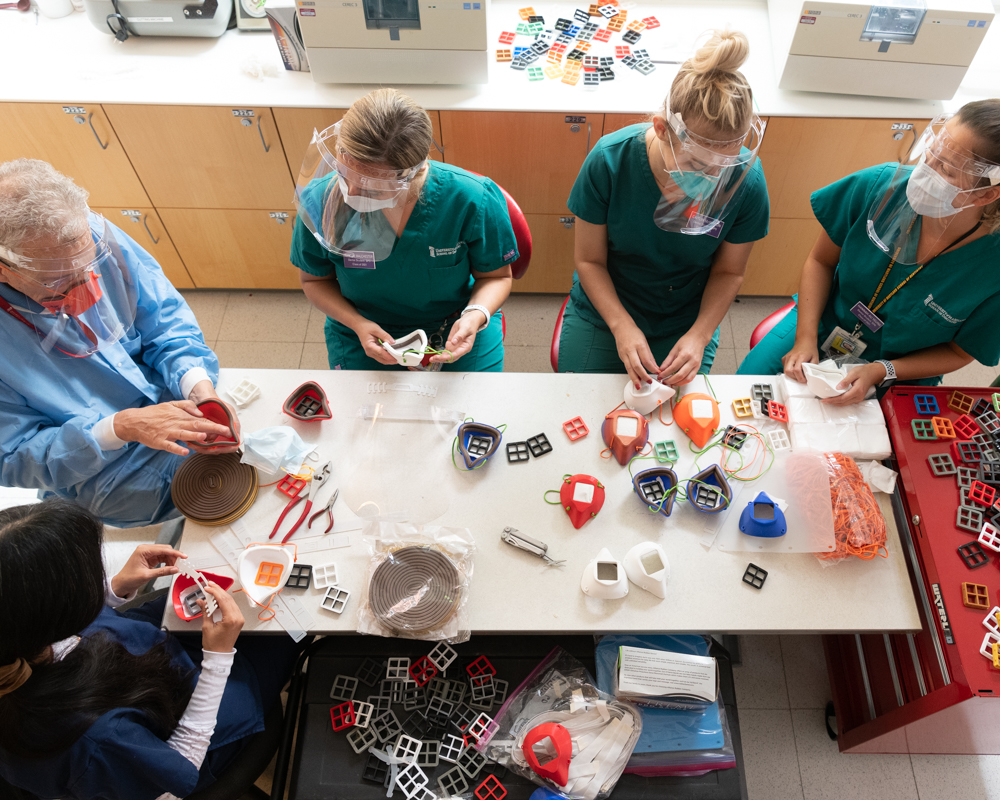Dental Student Secures 3-D-Printed PPE for UMB
September 15, 2020 Jen Badie
With personal protective equipment (PPE) shortages across the country, Kate Malchester saw a need and reached out to a donor, who gave the University 1,500 masks, 350 face shields, and 350 ear savers.
As COVID-19 began to spread, University of Maryland School of Dentistry (UMSOD) student Kate Malchester saw a need and acted to fill it.
Malchester, a fourth-year student, had previous knowledge about 3-D printing from her experience working for the National Institutes of Health. She also knew about the shortage of personal protective equipment (PPE) facing the country as the pandemic took its toll on health care workers. After seeing a news segment about volunteers creating 3-D-printed PPE in the Midwest, she reached out locally to research if this could be an option for UMSOD and the other University of Maryland, Baltimore (UMB) schools.
“We need to be safe; our patients need to be safe,” Malchester said.
She was pointed toward Steve Saint Amour of the Eclipse Group in Anne Arundel County, who along with his wife and daughter had been creating and donating 3-D-printed PPE to hospitals such as Anne Arundel Medical Center.
“I explained that I was at the dental school and we were looking to find more information on 3-D printing,” Malchester said. “I didn’t even ask him if he had PPE for us. I really just wanted to know more about it, and he offered us the printed Montana masks, which have been used at Anne Arundel Medical Center. It was just an act of kindness.”
Saint Amour donated 1,500 masks, 350 face shields, and 350 ear savers, which make wearing masks more comfortable, to UMB.
With the help of others with 3-D printers, Saint Amour had been printing the masks, which were designed by a neurosurgeon and dentist in Billings, Mont., and donating them to hospitals locally and nationally. He has donated more than 10,000 masks; he can print two masks in four hours.
“One of the big drivers for solving this [PPE shortage] problem are people like Kate,” said Saint Amour, who credited students with getting the word out about the 3-D printing.
He said the donation to UMB was the last one he made and that he gave Malchester everything he had left. He added that he and others are continuing to print the masks in case the need continues in the fall.
Malchester worked to secure the PPE with Gary Hack, DDS, associate professor, and Guadalupe Garcia Fay, DMD, clinical assistant professor, both with UMSOD’s Department of Advanced Oral Sciences and Therapeutics.
Hack and Fay have supported and encouraged Malchester to submit her project to the American Dental Education Association (ADEA) for presentation at the organization’s annual meeting.
“I thought it was incredible,” Hack said of Malchester’s idea. “It’s very exciting that one of our dental students, who are all very busy right now, would be thinking outside the box, thinking about other people and trying to help during this very difficult time. My first reaction was, ‘Wow, this is really great to work with a student who is so caring and visionary.’ ”
Hack, who picked up the materials from Saint Amour, plans to distribute them to the University of Maryland Medical Center, University of Maryland School of Medicine, and UMSOD once they are evaluated and approved. Malchester and fellow students are assembling the masks and shields, a process that is fairly simple.
Although the masks are not approved by the Food and Drug Administration, the Montana mask website (makethemasks.com) states that “the mask has been rigorously tested. The level of protection is customizable, depending on which material you use for the filter.”
The masks come in two sizes, and the changeable filters can be an N95-type filter insert or a surgical mask-type filter insert.
Hack also pointed out that because you only need a 2½-by-2½-inch square filter, the wearer can take an N95 mask and section it into six pieces and each one can be put into the 3-D-printed mask.
“You’re increasing your N95 mask by six times,” he said.
Hack, who is known for his interest in digital dentistry such as computer-aided design and computer-aided manufacturing (CAD/CAM) for dental restorations, believes the PPE is a safe option, particularly if shortages persist in the fall and winter when the flu will also be prevalent.
“The neurosurgeon in Montana and the dentist who have developed this have done all kinds of tests on it and showed in their testing that it is equal to if not better than other masks,” he said. “The CDC has said you can use alternative masks that are not FDA-approved during crunch times, so I think these can be used. I think they are absolutely as good if not better than what we have been using. The beauty of it is because the mainframe is plastic, you can disinfect it and use it over and over again.”
Malchester called having the 3-D-printed PPE on hand “preventative.”
“I think it’s just being able to give awareness, to let people know that there are other options in these trying times when supplies are low, that we can make certain materials to help,” she said. “We are just trying to help in the fight because we are all in this together. We have the technology, so let’s try to use it to help everyone."